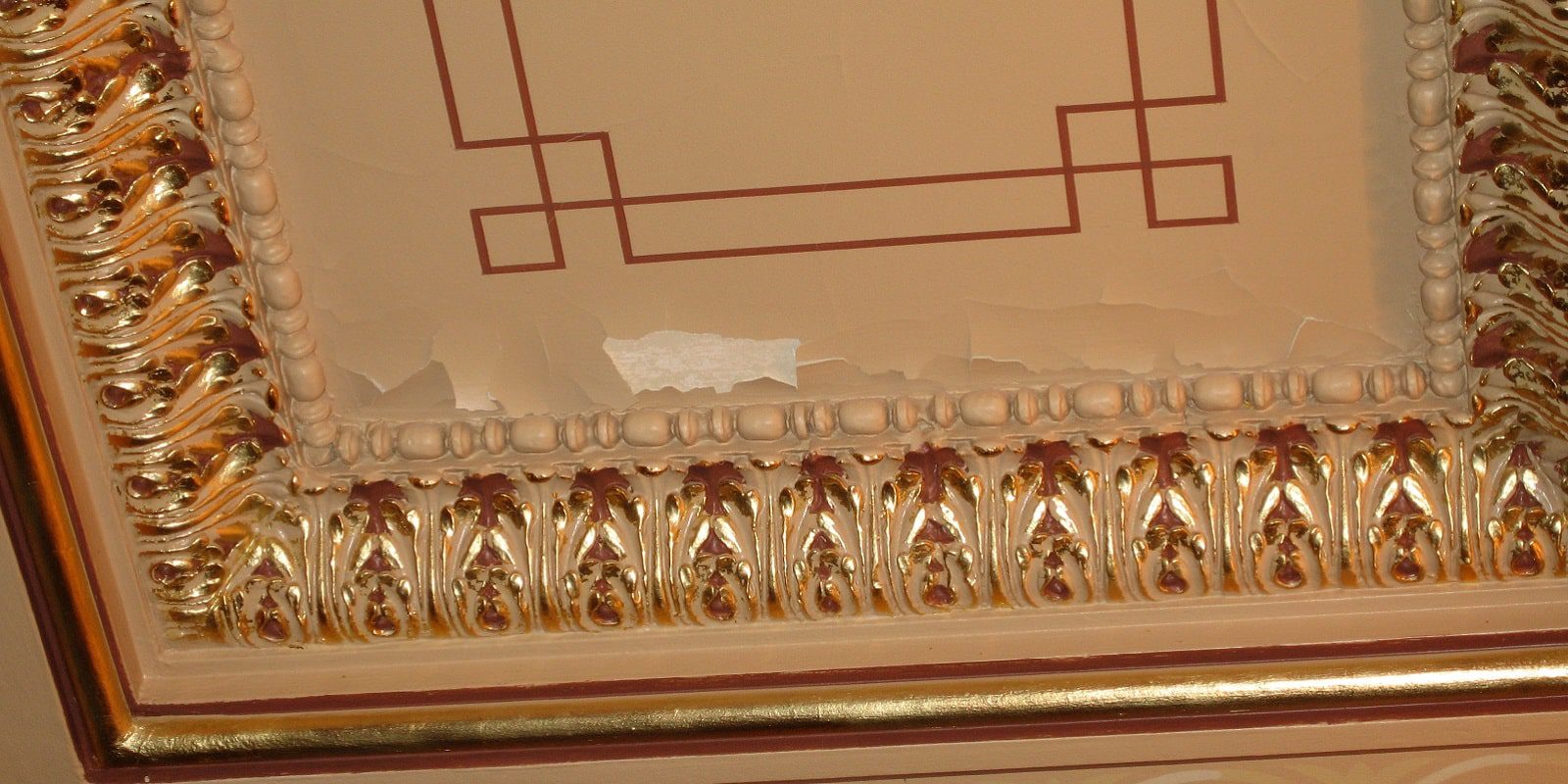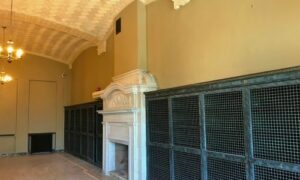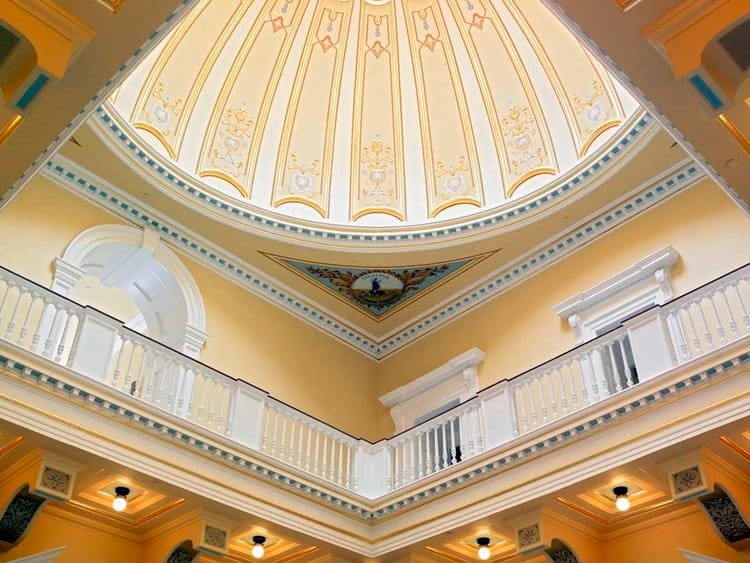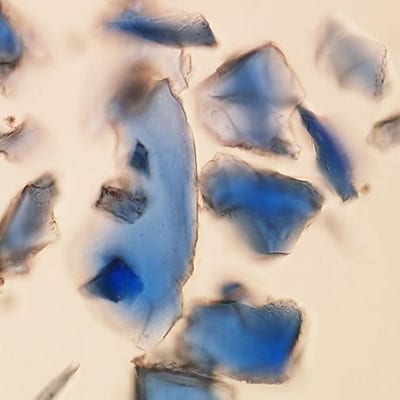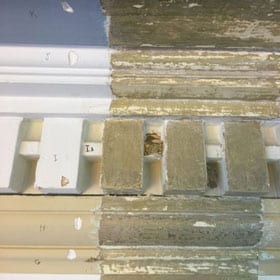Historical buildings have an integral role in our society – providing cultural, economic, and historic value from the past to present day. Critical to the conservation and preservation of our historical buildings is the commitment to timely paint restoration; without this maintenance process, detrimental occurrences such as paint failure will occur.
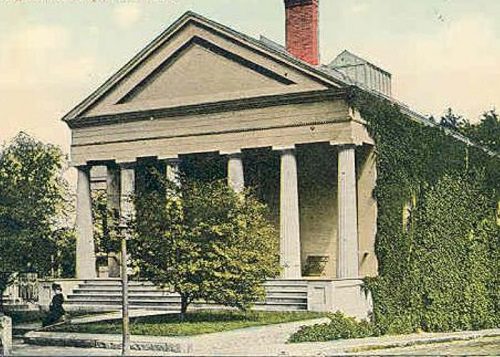
The Pilgrim Hall Museum
Types of Paint Failure
-
- Peeling/Incomplete Coatings
- Crazing
- Alligatoring / Cracking
- Solvent Blistering
- Chalking
- Staining
- Wrinkling
Paint surface conditions can range in severity due to common factors like time, light exposure, and high moisture content. Effects of these conditions can result in the following.
-
Peeling/Incomplete Coatings
Also known as “intercoat peeling”, this paint failure is the result of improper surface preparation. When a surface is improperly prepared for the new paint layer it fails to adhere properly, causing the layer to peel. Incompatible paint types to one another – Oil Based, Water Based, Latex Based – are secondary causes for peeling.
When several layers of paint become excessively hard and brittle, no longer having the ability to expand and contract with a wood substrate. This paint failure presents fine, jagged interconnected breaks in the top layer of paint. If not restored, additional moisture will gain access, prompting additional swelling and deep cracking / alligatoring.
-
Alligatoring / Cracking
The ultimate paint failure is when the bond between the initial and sub-layers of paint has diminishes all together due to intercoat paint failure. This paint failure creates an overall pattern of horizonal and vertical breaks in the multiple paint layers, creating the visual of reptile skin. In the worse cases, the surfaces will badly flake.
-
Solvent Blistering
Typically seen more in dark color paint applications, solvent paint or thinners absorb heat rapidly, making the drying process almost immediate. As the layers underneath set, solvents become trapped and vaporize, showing through the final paint layer.
-
Chalking
Considered the most ideal way for paint to age, chalking – the process of powdering the paint surface – is a form of paint failure. In moderation, this gradual disintegration of resin within the paint film makes for the ideal surface to repaint. If the paint is applied in a thick manner or contains a higher volume of pigment to binder volume ratio, excessive chalking can cause the paint to wash down onto a surface of different coloring. Excessive chalking will cause streaking and rapid disintegration of the paint film.
-
Staining
Oxidation is a primary cause for staining and occurs as moisture sets between wood and metal substrates. Metals like iron, steel, and copper when paired with a wood substrate can create rust and discoloration. A second cause for staining occurs when moisture and natural extractives from specialty wood like redwood or cedar wood chemically interact, causing a surface deposit of colored matter.
-
Wrinkling
Results of improper application; wrinkling occurs when paint is applied in excess volume, applied without the proper drying of layer before, improper surface preparation, or applied in high heat environments.
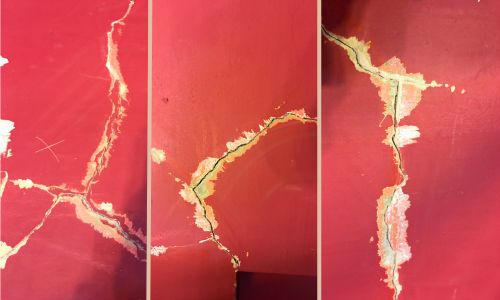
The Pilgrim Hall Museum – Steinway Library: Disintegrated Plaster & Paint Due to Water Damage
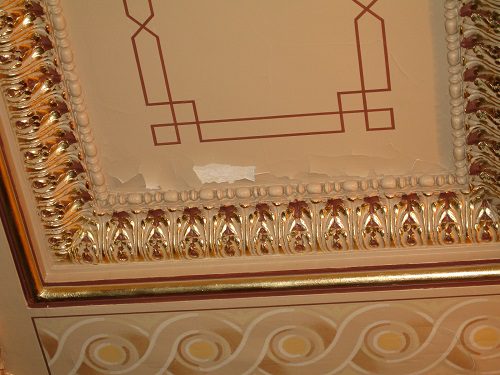
Paint damage from water issues at the Virginia State Capitol
Causes of Paint Failure
As mentioned, weathering will occur over time causing various types of paint failures for differing surface materials. Some agents of deterioration are moisture, sunlight, temperature, and environmental grime. Paint cannot adhere to a surface that contains more than 15% moisture, a professional conservator will be sure to perform a moisture meter test before applying the paint restoration technique. Moisture penetration can cause mold and mildew within paint layers, developing paint failures such as peeling, crazing, cracking / alligatoring, blistering, and staining.
Another deterioration agent is sunlight which can cause oxidation and blistering paint failure – the process of the final paint layer rapidly drying, causing vaporization of the trapped paint below, showing through to the finish layer. Environmental conditions and grime are also to note, as these elements tend to result in paint failures like crazing, wrinkling, and peeling. Over time, temperature and humidity can affect how ductile the substrate and applied paint react. Organic matter is guaranteed to cling to painted surfaces and if painted over rather than removed, the grime can prevent proper adhesion, causing peeling. Dirt, pollution, and temperature conditions fall between CLASS I & II of determining paint removal before restoration, these CLASS levels require little to no paint removal to begin the restoration process.
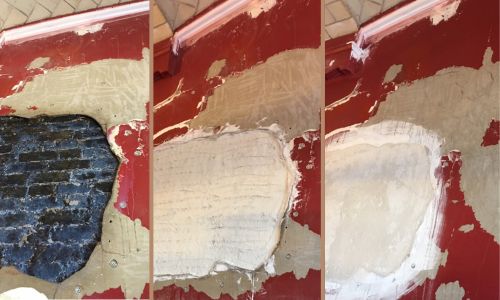
The Pilgrim Hall Museum – Steinway Library: Plaster Restoration
Paint Failure Has Occurred – Now What?
In order to determine the proper restoration process and technique, our trusted conservation professionals at John Canning & Co. will perform a finish assessment and historic paint investigation. This process entails the review of the historic building through archival research – primary and secondary sources – to understand the historical context of the work being analyzed. Following this research, our conservators perform a scientific historic paint analysis from on-site exposures and sampling, later providing a report and interpretation of findings. These findings help guide the restoration or conservation process.
The Pilgrim Hall Museum – Steinway Library: Completed Plaster & Paint Restoration to Historic Appearance
Your Preservation Problem Solvers
Time and environmental factors play a large role in the process of paint failure. Paint restoration can help to return the original color and appearance of a historical building, which is an essential part of preserving its historical character. By restoring these colors and designs, we can honor the architectural style and design of the past and maintain the building’s cultural value.
John Canning & Co. is an architectural arts restoration contractor with over 45 years’ experience. We are one of the nation’s experts in historic restoration, conservation, and preservation. John Canning & Co. is an expert specializing in services in the architectural arts and finishes. The type of projects that we work on include national landmarks, religious establishments, educational institutions, government buildings, museums, theatres and entertainment venues. We are expert Preservation Problem Solvers with a goal of Perfecting Preservation. We find the architectural arts restoration, preservation and conservation solutions for the most complex problems and situations. Even after years of historic restoration of the country’s most prestigious landmarks, we remain awestruck by the majesty and history that these buildings hold, and are most honored to help keep their history alive. If you have a project that needs our expertise, contact us today.

